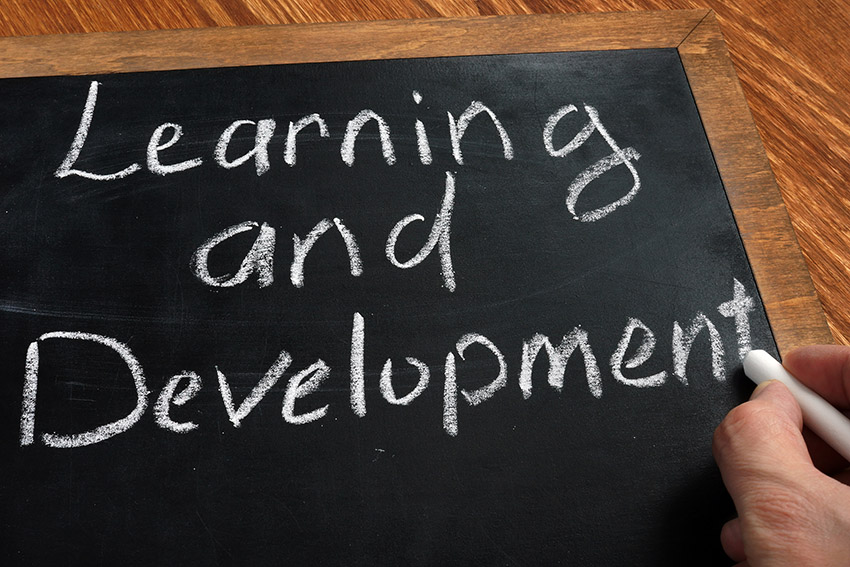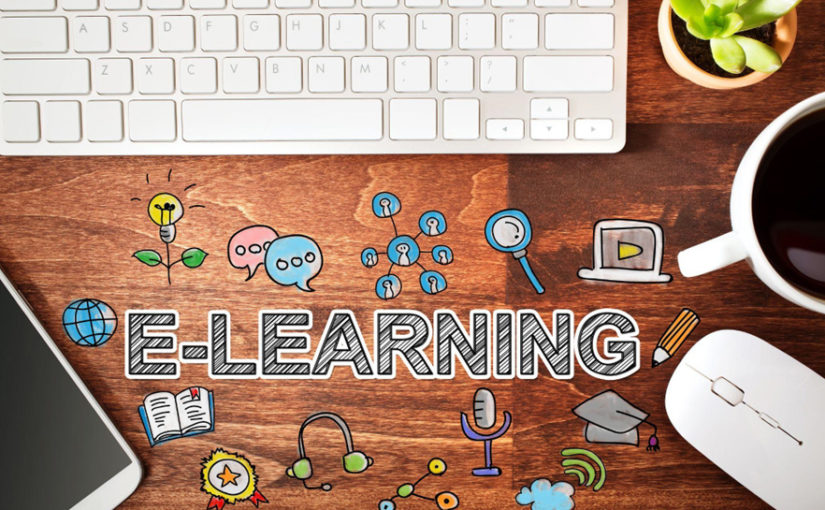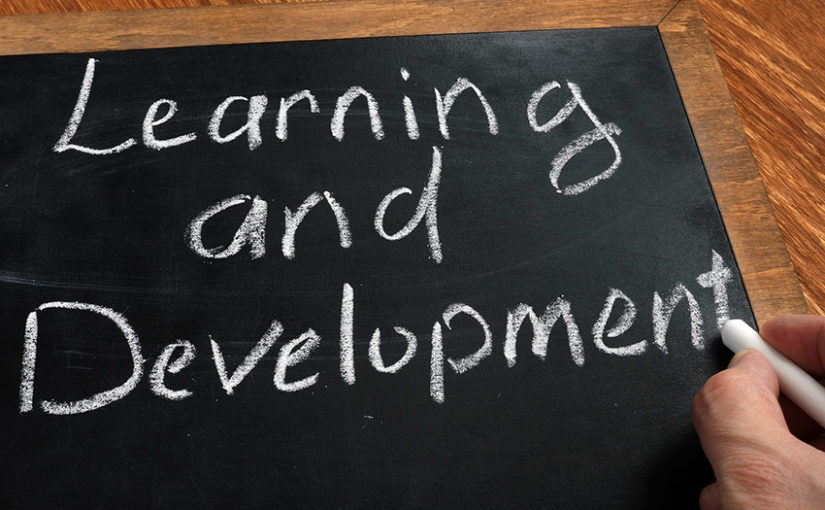
Understanding the essential elements for a winning L&D strategy is crucial for any organisation aiming to create growth and innovation.
As an eLearning company, we recognise the importance of aligning educational goals with business objectives to create impactful learning experiences.
This blog explores the key components that can transform your approach to staff development, ensuring your training efforts are both effective and efficient. Join us as we delve into these fundamental elements, tailored to enhance the learning landscape of any forward-thinking company.

What is an L&D Strategy?
A Learning and Development (L&D) strategy outlines the framework and processes that an organisation uses to enhance the skills, knowledge, and competencies of its employees.
This strategy is essential in modern workplaces as it directly impacts employee engagement, productivity, and overall business performance.
By systematically addressing learning needs and aligning them with business goals, an L&D strategy ensures that the workforce remains agile, competitive, and capable of meeting future challenges.
Such an approach is particularly important in industries, such as technology and communications, where there is rapid and regular change.
In such organisations, it pays to create a culture of continuous learning, so that employees internalise the process of self-development, understanding that it contributes to their success and career advancement.
A thorough L&D strategy should incorporate corporate culture, techniques for L&D, and a demonstration of how training is aligned with the company’s strategic vision.

Learn How To Create Personal Learning Journeys For FREE!
Creating an Effective L&D Strategy
Shaping a winning L&D strategy from scratch involves several steps.
Key considerations to bear in mind, and steps to take, include:
1. Assess Organisational Needs
Begin by identifying the current and future skill requirements of your organisation. This involves conducting a thorough needs analysis to understand any gaps in competencies and the areas that require development.
Example: As AI comes to dominate data analytics and process automation, do staff need specific training around its use and complexities?
2. Define Clear Objectives
Set specific, measurable, achievable, relevant, and time-bound (SMART) objectives for your L&D initiatives. These objectives should align with the broader business goals to ensure that training efforts contribute to organisational success.
Example: You might decide to ensure that all staff are trained on a new sales platform within the first two quarters of the next business year.
3. Develop a Curriculum
Create a comprehensive curriculum that addresses the identified needs.
This should include a mix of formal training programs, on-the-job learning, mentoring, and self-directed learning opportunities.
Example: You might identify the mandatory online training staff must complete and offer three optional classes to develop new skills.
4. Choose the Right Delivery Methods
Select appropriate delivery methods that suit the learning preferences of your employees. This could range from traditional classroom training and workshops to eLearning modules and virtual training sessions.
Example: You might decide that mandatory courses can be completed online in the employees’ own time, but optional upskilling should take place in-person.
5. Implement and Monitor
Roll out the L&D programs and continuously monitor their progress. Collect feedback from participants to make necessary adjustments and improvements.
Example: Use a mandatory but anonymised online feedback form to make sure you get all the information you need about how employees feel about the L&D programme.
6. Evaluate and Adjust
Regularly evaluate the effectiveness of your L&D strategy using various metrics and feedback mechanisms. Use this data to refine and enhance the strategy, ensuring it remains relevant and impactful.
Example: for online courses, you may be able to obtain detailed data analytics on time taken for tasks, number of quiz questions failed, and more. You can then adjust the course materials appropriately.

10 Essential Elements for Your L&D Strategy
A winning L&D strategy comprises ten key elements. Here is a detailed breakdown of each part of a typical strategy:
1. Leadership Support
Having strong buy-in from senior management is crucial for the success of any L&D initiative.
Leaders should advocate for learning and actively participate in development programs to set a positive example.
2. Employee Engagement
Engaging employees in the learning process ensures higher participation and retention rates.
Use interactive and engaging content to make learning more appealing. There are several methods you can use to make the process more enjoyable including gamification, completion rewards, and team competitiveness.
3. Continuous Learning Culture
Create a culture that values continuous improvement and learning. Encourage employees to seek new knowledge and skills regularly. Make it clear why each course has been deemed necessary or valuable.
You can use discussion forums to encourage peer support and information sharing, which will help create a positive attitude to L&D.
4. Personalised Learning Paths
Develop personalised learning paths that cater to the individual needs and career aspirations of employees.
This tailored approach enhances the relevance and impact of training. According to a recent eLearningindustry.com survey, 77% of L&D professionals think this element is essential to engagement. Gone are the days of “one size fits all” training plans.
5. Technology Integration
Employ modern technologies such as Learning Management Systems (LMS), mobile learning apps, and virtual reality (VR) to create a dynamic and flexible learning environment.
Price Waterhouse Cooper recently published a study on what is now known as “V-learning,” which included these findings:
- Learner confidence was boosted by 40% over classroom methods and 35% more than traditional e-learning.
- V-learners completed their programmes four times faster than classroom learners.
- Focus was improved up to four times more than with e-learning and was 1.5 times better by students using VR over learning in a classroom setting.
6. Data-Driven Decision Making
Use data analytics to track learning progress and outcomes.
This data-driven approach helps in making informed decisions and improving the effectiveness of L&D programs.
e-learning and v-learning lend themselves more to measurable metrics. However, all L&D methods can be evaluated with user surveys, pass scores, completion time, and other KPIs.
7. Collaboration and Social Learning
Promote collaborative learning through group activities, discussions, and social learning platforms.
This helps with knowledge sharing and creates a sense of community. Avoid letting individual learners feel isolated and under pressure. Make course completion a team goal and learners will push one another to new heights.
8. Skilled L&D Team
Don’t forget to train and upskill the trainers!
Ensure that your L&D team is skilled and knowledgeable, particularly in new methods such as v-learning and new subjects such as AI automation and holistic wellness.
Invest in their professional development to keep them updated with the latest trends and corporate training best practice.
9. Alignment with Business Goals
Align L&D initiatives with the strategic objectives of the business. This ensures that the training efforts are directly contributing to organisational growth.
For example, if a company is incorporating tools such as AI assistants to aid sales teams, make sure the business includes automation and AI enablement as one of its corporate goals.
10. Feedback Mechanisms
Establish robust feedback mechanisms to gather insights from learners and stakeholders. Use this feedback to continually improve the L&D strategy.
As previously mentioned, invite honest, open, and anonymised feedback, to get the most truthful responses. If asked face to face within a group, most respondents will temper their opinions to be agreeable. You don’t want that.

Incorporating Learning & Development Best Practices
To maximise the outcomes of your L&D strategy, it is essential to incorporate established corporate training best practices. These include the following approaches:
Embrace Blended Learning
Combine various learning methods, such as in-person training, online courses, and hands-on activities, to cater to different learning styles and preferences.
“Soft skills” such as empathic leadership and conflict resolution require person-to-person interaction and roleplay, therefore these are best taught in group settings, whereas other subjects can be effectively learnt online.
Focus on Soft Skills
In addition to technical skills, emphasise the development of soft skills such as communication, leadership, and teamwork, which are critical for overall employee performance.
A LinkedIn survey of hiring managers reported that 92% cited soft skills as hugely important to new hires. Every employee should value these skills.
Encourage Self-Directed Learning
Empower employees to take charge of their own learning by providing access to resources and tools that support self-directed learning.
Such resources may include online libraries, video tutorials, interactive quizzes, and forums for sharing information and tips.
Leverage Microlearning
Use microlearning techniques to deliver content in bite-sized, easily digestible chunks. This approach enhances retention and fits well into busy schedules.
Many project management or work solutions allow pop-up tips and tricks. These can be an invaluable way to share links to new developments, articles, and functions that may prove helpful.
Provide Continuous Support
Offer continuous support through coaching, mentoring, and regular follow-ups. This helps in reinforcing learning and applying new skills effectively.
Mentoring is one of the oldest, and most often overlooked, ways to support ambitious employees (and prevent them jumping ship).
In a rapidly changing workplace, reverse mentoring, which pairs an older and more experienced worker with a younger one to mutually share information, has become popular.

Professional Development Strategies
Enhancing professional growth and development through effective training involves various professional development strategies.
Such strategies track an employee’s learning throughout their time with an organisation. Management should support employees’ personal development strategies because it demonstrates an interest in developing employees, rather than viewing them as slotting into roles without a chance of advancement.
A personal development strategy might include:
Career Development Plans
Create personalised career development plans that outline the path for employees to achieve their career goals.
This should include specific learning and development activities. Such plans should be written in consultation with an employee, since all workers have different degrees of ambition, different interests, and notions of their own career progression.
Don’t assume, for instance, that everyone craves managerial seniority. Many creative workers do not hold this as a personal priority.
Leadership Development Programs
Implement leadership development programs to prepare future leaders. Focus on building essential leadership skills and competencies.
Soft skills are a key part of such programs, helping leaders develop people-centred skills that should give them an advantage over other candidates for leadership.
Cross-Functional Training
Encourage cross-functional training to provide employees with a broader understanding of the organisation. This helps in creating a more versatile and adaptable workforce.
Techniques to employ might include acting-up into different roles for limited periods of time, shadowing, or mentorship.
Certification Programs
Offer certification programs to validate the skills and knowledge acquired by employees. This adds value to their professional credentials.
Hubspot is a good example of a company that has developed a whole range of certifications, and a dedicated virtual academy, to help users benefit from the more complex functions of its sales platform.
Networking Opportunities
Facilitate networking opportunities through conferences, workshops, and professional groups. This helps employees expand their professional network and gain new insights.
You can promote shared learning by asking attendees to summarise and share the key insights from such event attendance.
Performance Appraisals
Use performance appraisals to identify opportunities for development. Provide constructive feedback and set clear development goals.
Try to make these non-judgemental and aimed at identifying both good performance and areas for improvement.
Innovative Workplace Learning Solutions
Modern solutions and technologies that enhance learning in the workplace include:
eLearning Platforms
Adopt comprehensive eLearning platforms that offer a wide range of courses and learning materials. These platforms provide flexibility and convenience for learners.
Virtual Reality (VR) Training
Use VR technology to create immersive and interactive training experiences. This is particularly effective for complex or hands-on training scenarios.
Mobile Learning
Implement mobile learning solutions that allow employees to access training materials on their mobile devices. This supports learning on-the-go.
Gamification
Include gamification methods in your training programs to make learning more motivating and engaging.
Use leaderboards, badges, and rewards to incentivise participation.
Artificial Intelligence (AI)
Consider employing AI to personalise learning experiences and provide real-time feedback. AI can also help in identifying skill gaps and recommending relevant training.
Elearningindustry.com produced a rundown of the best AI tools for training which might be worth a look if you’re considering AI for this function.

Roadmap to a Successful L&D Strategy
Planning and executing an L&D strategy with a long-term vision involves several key steps:
1: Set Clear Vision and Goals
Define a clear vision and long-term goals for your L&D strategy. Ensure that these goals are aligned with the overall business strategy.
2: Engage Stakeholders
Involve key stakeholders in the planning process to gain their support and ensure that the L&D strategy meets their expectations and needs.
3: Develop a Detailed Plan
Create a detailed L&D strategy roadmap that outlines the specific actions, timelines, and resources required to achieve the L&D goals.
4: Communicate the Strategy
Effectively communicate the L&D strategy to all employees and stakeholders. Use various channels to ensure that everyone understands the importance and benefits of the strategy.
5: Monitor Progress
Regularly track the progress of your L&D initiatives. Use key performance indicators (KPIs) to track the effectiveness and impact of the strategy.
6: Adapt and Evolve
Be prepared to adapt and evolve your L&D strategy based on feedback and changing business needs. This ensures that the strategy remains relevant and effective.
Evaluating the Success of Your L&D Strategy
Use a variety of metrics and methods to assess the success of your L&D strategy. These can include:
- Employee Feedback: Collect feedback from participants to gauge their satisfaction and the perceived value of the training.
- Performance Metrics: Analyse performance data to measure the impact of training on employee productivity and efficiency.
- Business Outcomes: Evaluate the contribution of L&D initiatives to achieving business objectives, such as increased revenue or market share.
- Learning Analytics: Use these to track engagement, completion rates, and knowledge retention.
Adapting Your L&D Strategy to Changing Needs
Maintaining flexibility and responsiveness in your L&D strategy is crucial in today’s dynamic business environment:
Stay Updated with Trends
Keep abreast of the latest trends and advances in the L&D field. This helps in incorporating innovative workplace learning solutions and technologies into your strategy.
Solicit Continuous Feedback
Continuously gather feedback from employees and stakeholders to identify areas for improvement. Use this feedback to make necessary adjustments.
Create a Culture of Agility
Promote a culture that embraces change and agility. Encourage employees to be adaptable and open to new learning opportunities.
Regularly Review and Revise
Regularly assess and modify your L&D strategy to ensure it remains aligned with the changing needs of the business and the workforce.
The Future of L&D
Learning and Development is becoming more dynamic and transformative.
As organisations handle the shifting complexities of the modern workplace, having a robust L&D strategy is more critical than ever.
Embracing innovative technologies, creating a culture of continuous learning, and aligning training with business goals are essential for staying competitive.
Explore our eLearning content and discover how our eLearning Platform can enhance your L&D strategy.
For immersive learning experiences, take a look at our Virtual Training.













